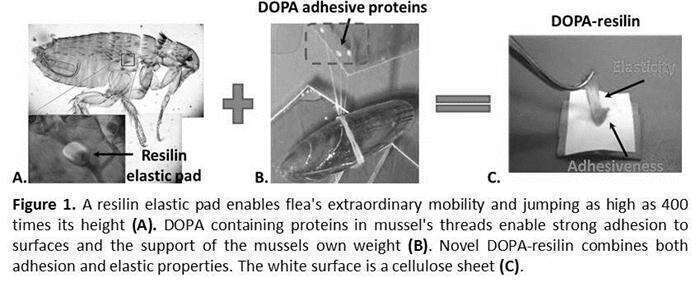Adhesives, a 20-million-tonne global industry, relay almost completely on petrochemical sources. In times of increasing emission of greenhouse gasses and depleting fossil reserves, development of high performing bio-adhesives are of high interest and challenge. Potential solution for such a challenge is based on DOPA-functionalized resilin and Nano Crystalline Cellulose (NCC). Resilin is an insect's protein (Figure 1.A) and considered as being the most elastic material in nature. Its unique mechanical properties combine high elasticity of 97%, exceeding all available synthetic rubbers 1. Cellulose, the most abundant and renewable biopolymer on earth, contains highly crystalline regions. These regions can be processed into Nano-scale crystals that have a tensile strength similar to super strong materials such as aramid fibers 2. DOPA-proteins are considered as being the strongest non-covalent adhesives on earth. Mussels use these proteins for adherence to organic and inorganic materials under water (Figure 1.B) 3. Inspired by the remarkable elasticity of resilin, the strength of NCC and the adhesion strength of DOPA-proteins, we fused a cellulose binding domain (CBD) to the resilin and also modified it to create DOPA-resilin. Hence, we paved the way to create novel DOPA-resilin-CBD/NCC Nano-composite adhesives. Preliminary results showed good adhesion of the DOPA-resilin to both inorganic and organic surfaces (figure 1.C). Recently, we were also successful in integrating NCC and resilin with Epoxy-based adhesives. In future, resiln/NCC composites would be integrated in all-plant-derived adhesives, such as polyurethanes, resulting in enhanced adhesives relaying only on bio-based and renewable materials.

Reference
1. Qin G et al. Biomacromolecules 2009; 14;10(12):3227-34.
2. Lee KY et al. ACS Appl. Mater. Interfaces 2012; 22;4(8):4078-86.
3. Lee BP et al. Annu Rev Mater Res 2011; 1;41:99-132.

